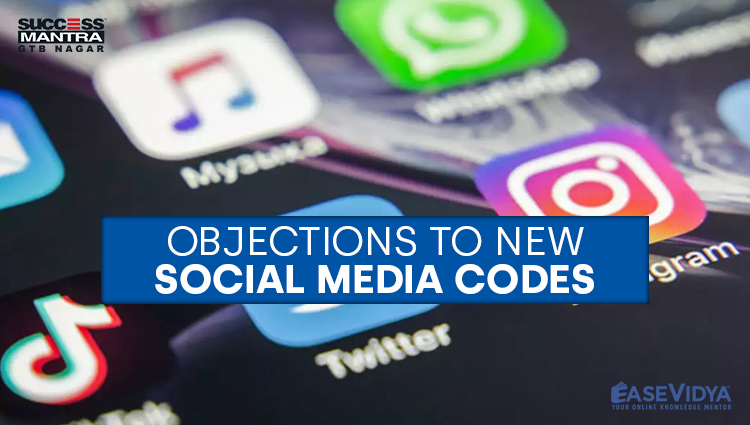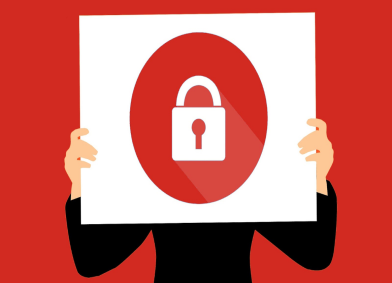
OBJECTIONS TO NEW SOCIAL MEDIA CODES
OBJECTIONS TO NEW SOCIAL MEDIA CODES
The latest norms for social media intermediaries in the New IT Rules 2021 have drawn objections from privacy experts and lawyers. The Supreme Court (SC) had in 2015 struck down Section 66A of the Information Technology Act finding it contrary to both Articles 19 (free speech) and Article 21 (right to life) of the Constitution.
OBJECTION TO NEW RULES

Asking ‘significant social media intermediaries’ to have automated tools to proactively track certain words is akin to “active hunting”, and will “make suspects out of people”. For example: For track words like interfaith marriage or love jihad, its like criminalising an entire population as most of the people must be using these words in their normal discussions. This way, an entire citizenry is being made a suspect.
Against Right to Privacy: According to the New IT Rules of 2021, significant social media intermediaries providing services primarily in the nature of messaging shall enable identification of the first originator of the information. This provision would end up weakening overall security, harm privacy and contradict the principles of data minimisation endorsed in the IT Ministry’s Draft Data Protection Bill 2019. Identification of the first originator will require end to end encryption to be broken, thereby compromising the fundamental technology on which most apps are based on. Moreover, owing to the volume of data, encryption has become more important now as more personal data is being aggregated and analysed at a scale that was never possible before.
Data Minimisation: Data Minimisation is a principle that states that data collected and processed should not be held or further used unless this is essential for reasons that were clearly stated in advance to support data privacy. It will “undermine the principles of open and accessible internet and the fundamental right of privacy enshrined in the Constitution, particularly in the absence of robust data protection law. For Example: It contains a provision requiring significant intermediaries to provide the option for users to voluntarily verify their identities.
This would likely entail users sharing phone numbers or sending photos of government issued IDs to the companies. This provision will incentivize the collection of sensitive personal data that are submitted for this verification, which can then be also used to profile and target users
RIGHT TO PRIVACY

The SC described privacy and its importance in the landmark decision of K.S. Puttaswamy v. Union of India in 2017 as a fundamental and inalienable right and attaches to the person covering all information about that person and the choices that he/ she makes. The right to privacy is protected as an intrinsic part of the right to life and personal liberty under Article 21 and as a part of the freedoms guaranteed by Part III of the Constitution.
Against Freedom of Expression: Automated forms of censorship and surveillance could disproportionately impact users’ freedom of speech and expression, suppressing creativity. Article 19(1)(a) of the Indian constitution guarantees the freedom of speech and expression.
Over Censorship: The new rules provide stricter and wide-ranging obligations on intermediaries for proactive monitoring of content. The fear of legal liability or action could lead to over-censorship of content.
Lack of Accountability and Transparency: The news rules require social media to “deploy technology-based measures, including automated tools (Artificial Intelligence (AI)) to filter out objectionable content like child sexual abuse. However, as history has shown, such tools not only suffer from major accuracy problems but also can lead to function creep. Earlier in 2020 an AI-powered tool Genderify designed to identify a person’s gender by analyzing their name, username or email address was shut down just a week after launch after it was blamed to be biased. Coding biases in the development of AI often lead to discrimination, inaccuracies, and a lack of accountability and transparency.
Gag on Online News Media: The rules open the way for increased scrutiny as well as increased costs of compliance and may lead to gagging of free and unhindered news reporting.
QUESTIONS (1-5)
Q.1 Which of the following sections of the IT Act was recently struck down by SC finding it contrary to both Articles 19 and Article 21 of the Constitution?
- Section 55B
- Section 66A: ANSWER
- Section 62A
- None of the above
Q.2 Consider the following statements and state which of the following is/are incorrect in the reference to the above mentioned passage?
- The new IT rules obstructs the provisions of Article 19 which talks about freedom of speech and expression & Article 21 about Right to education (RTE).
- Significant social media intermediaries providing services primarily in the nature of messaging shall enable identification of the first originator of the information
- Only I follows
- Only II follows: ANSWER
- Both I & II are correct
- None is correct
Q.3 Which of the following can be included in Right to life under Article 21 of the Indian Constitution?
- Right of a person not to be subjected to bonded labour or to unfair conditions of labour.
- Right of a bonded labourer to rehabilitation after release.
- Right to privacy refers to the concept that one's personal information is protected from public scrutiny
- I, II and III follows: ANSWER
- I and II follows
- Only III follows
- None of the above
Q.4 Consider the following statements and state which of the incorrect in reference to the above passage?
- Intermediaries’ includes providers of telecom service, network service, Internet service and web hosting, besides search engines, online payment and auction sites, online marketplaces and cyber cafes.
- Intermediary is defined in Section 2(1) (w) of the IT Act, 2005: ANSWER
- Centre can ask any agency of the government, to block access to the public of any information generated on the ground mentioned in Section 69 of the IT Act.
- None of the above
Q.5 Which of the following statements is/are correct in the context of the OTT & digital platforms regulation in India?
- Legal Recognition to Digital Signatures, Regulation of Certification Authorities, Digital Certificates all are components of IT Act 2000.
- India's government has issued an order bringing the regulation of online news portals and content providers such as Netflix under the authority of the Ministry of Information and Broadcasting.
- There are altogether 6 schedules under the IT ACT 2000.
- I & III follows
- II & III follows
- I & II follows: ANSWER
- None of the above













dabmmpffgg
Muchas gracias. ?Como puedo iniciar sesion?